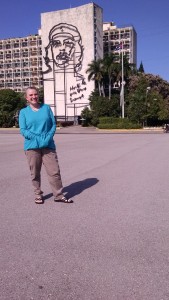“The relationship between Cuba and the United States is like a love affair between the ant and the elephant. Even if they love each other very much, if the elephant rolls over in the middle of the night, the ant is dead.”
— Jorge Mario Sánchez, Economist at the University of Havana
A love story between the U.S. and Cuba may seem unthinkable to those of us raised on a steady diet of negative messages about the island. Cuba is a “state sponsor of terror”[i] and a “communist tyranny,”[ii] according to the U.S. government. Until recently, the relationship between the two nations seemed to be an unbreakable stalemate, strained by mutual distrust and suspicion rooted in Cold War hostilities. [iii]
It may come as a surprise, then, to learn that the United States and Cuba have:
- A cooperative and professional military-to-military relationship governing borders on land and at sea
- Mutually beneficial, market-conforming, large scale agricultural trade
- Effective bilateral migration agreements between sovereign equals
- Long-lasting, tightly coordinated hurricane tracking protocols and frequent information-sharing between national weather services and science bureaus
- People with mutual appreciation of one another’s music, art, scholarship, and culture
- Large diplomatic missions posted in their respective capital cities[iv]
There are strong cultural ties, too, between the United States and Cuba. Cubans watch American television shows and U.S. newspapers. Many have relatives and friends in the states. South Florida is home to over one million Cuban immigrants, and as the Jimmy Buffett song says, “Everybody’s Got a Cousin in Miami.” Cuban artists and musicians like Desi Arnaz, Celia Cruz and the Buena Vista Social Club have influenced popular culture, introducing Americans to new musical forms like salsa, rumba, mambo and cha-cha-cha.
Yet for over fifty years, Havana and Washington have been separated by a political, ideological and economic gulf that belies their geographic proximity. Why is that our respective governments have been unable to bridge the differences between them despite successful cooperation on tactical matters like migration, border management, and disaster response? That question was one of the many mysteries that confronted us as we traveled to Cuba last month.
References:
[i] The U.S. State Department has included Cuba on its State Sponsors of Terrorism list since 1982. http://www.state.gov/r/pa/ei/bgn/2886.htm
[ii] The Cuban Liberty and Democratic Solidarity (also known as LIBERTAD or Helms-Burton) Act of 1996. 22 U.S.C. §§ 6021. Public Law 104-14, 110 Stat. 785. http://thomas.loc.gov/cgi-bin/query/z?c104:H.R.927.ENR: http://thomas.loc.gov/cgi-bin/query/F?c104:1:./temp/~c104BS5iUP:e4317:
[iii] Peter Baker, The New York Times, Dec. 17, 2014. http://www.nytimes.com/2014/12/18/world/americas/us-cuba-relations.html?_r=0
[iv] Domínguez, Jorge I. “Reshaping Relations Between the United States and Cuba,” in Debating U.S.-Cuba Relations: Shall We Play Ball? Edited by Jorge I. Domínguez, Rafael Hernández, and Lorena G. Barberia. http://www.people.fas.harvard.edu/~jidoming/images/jid_reshaping.pdf



